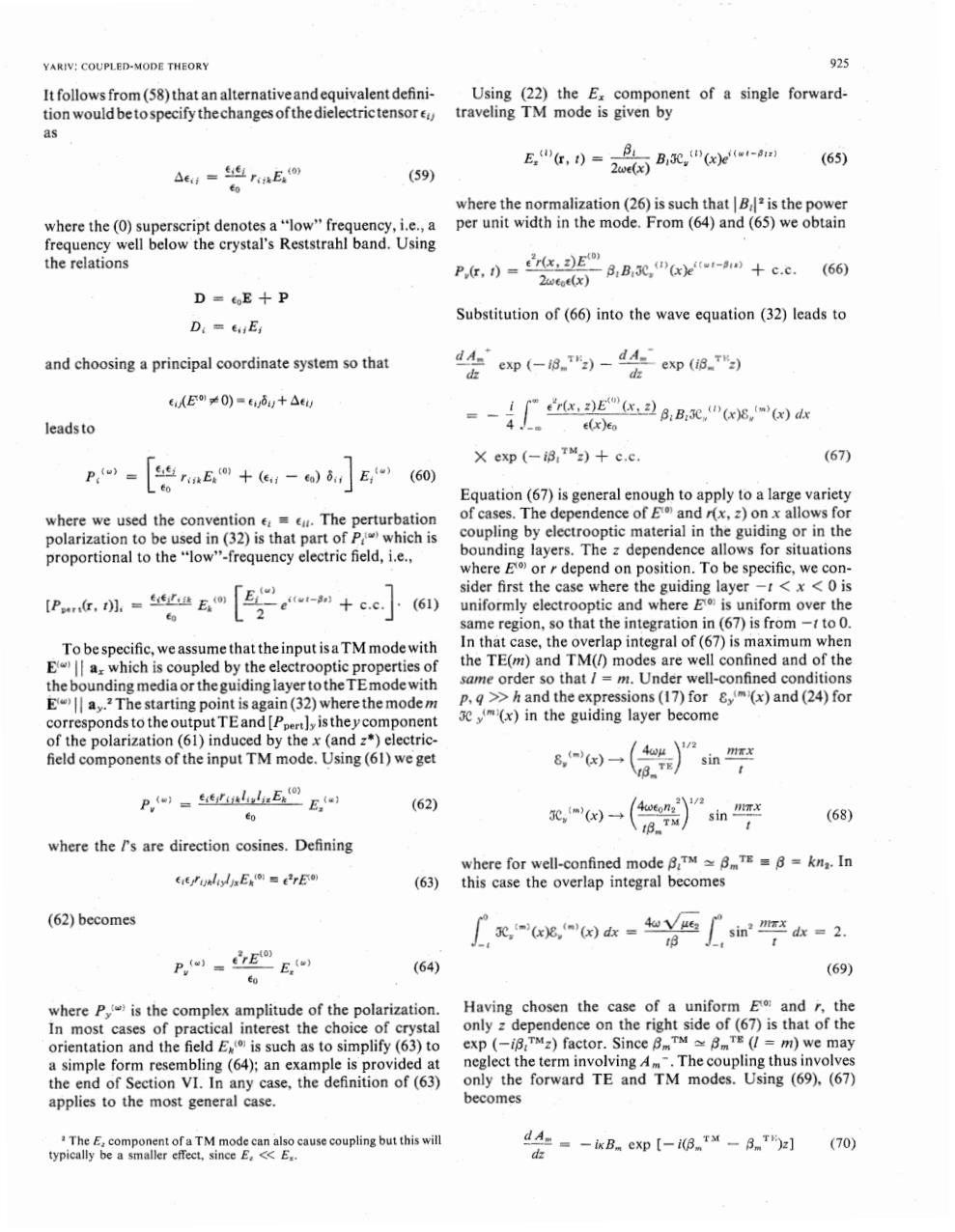正在加载图片...

YARIV:COUPLED-MODE THEORY 925 It follows from(58)that an alternativeandequivalent defini- Using (22)the Ex component of a single forward- tion would betospecify thechanges ofthe dielectrictensor traveling TM mode is given by as C (65) △eg=SrEo (59) E,”红,0=2e8 where the normalization(26)is such that|B2is the power where the (0)superscript denotes a"low"frequency,i.e.,a per unit width in the mode.From(64)and(65)we obtain frequency well below the crystal's Reststrahl band.Using the relations Pc,)=ex,Eo t)B,(+c.c. (66) D=E+P Substitution of (66)into the wave equation (32)leads to D=E and choosing a principal coordinate system so that d4cxp(-8.)-4ep限.到 d止 c(Eo*0)=6i,+△e rx,2E"c2BB30,(x8,)dk leads to E(x)Eo Xexp(-iB,TM2)十c.c. (67) P () )+(-(o)8 E t) (60) Equation(67)is general enough to apply to a large variety where we used the convention e=e.The perturbation of cases.The dependence of E and r(x,z)on x allows for polarization to be used in (32)is that part of P which is coupling by electrooptic material in the guiding or in the proportional to the "low"-frequency electric field,i.e., bounding layers.The z dependence allows for situations where E or r depend on position.To be specific,we con- [P()=E [wn+ee sider first the case where the guiding layer -t<x <0 is (61) uniformly electrooptic and where E is uniform over the same region,so that the integration in(67)is from-t to 0. To be specific,we assume that the input is a TM mode with In that case,the overlap integral of(67)is maximum when Ea which is coupled by the electrooptic properties of the TE(m)and TM()modes are well confined and of the the bounding media or the guiding layer to the TEmode with same order so that /=m.Under well-confined conditions Ea,.2 The starting point is again(32)where the mode m p,q>>h and the expressions(17)for 8,(m(x)and (24)for corresponds to the output TEand [Ppert],is theycomponent cm(x)in the guiding layer become of the polarization(61)induced by the x(and z*)electric- field components of the input TM mode.Using(61)we get 8mx)→ 4oμ IB TE PttbluEE (62) 2\1/2 Eo 3C,m(x)→ 18.TM sin x (68) where the Is are direction cosines.Defining where for well-confined mode B.TMBmT=8=kna.In ctualiyljsEx=erE) (63) this case the overlap integral becomes (62)becomes P.(='rg(o) -E ( (64) (69) where P,is the complex amplitude of the polarization. Having chosen the case of a uniform Eto and r,the In most cases of practical interest the choice of crystal only z dependence on the right side of(67)is that of the orientation and the field E is such as to simplify (63)to exp (-i8,TMz)factor.Since BTMmTE(I=m)we may a simple form resembling(64);an example is provided at neglect the term involving Am.The coupling thus involves the end of Section VI.In any case,the definition of (63) only the forward TE and TM modes.Using(69).(67) applies to the most general case. becomes The E,component ofa TM mode can also cause coupling but this will typically be a smaller effect,since E.<<E. 会=-kB.ep-0.m-.(0YAKIV: COUPLED-MODE THEORY It follows from (58) that an alternativeand equivalent definition would be to specify thechanges of the dielectric tensor ciJ as 925 where the (0) superscript denotes a "low" frequency, i.e., a frequency well below the crystal's Reststrahl band. Using the relations and choosing a principal coordinate system so that where we used the convention ci = cii. The perturbation polarization to be used in (32) is that part of Picw1 which is proportional to the "low"-frequency electric field, i.e., To bespecific, weassume that theinput isaTM modewith E(W1 I I a, which is coupled by the electrooptic properties of the bounding media or theguiding layer to theTEmodewith ElW) 1 1 aY., The starting point is again (32) where the modem corresponds to the output TEand [PpertIyis they component of the polarization (61) induced by the x (and z*) electricfield components of the input TM mode. Using (61) weget py(w) = e.t.y.. z 1 r1k I. tv 1. 12 Ek(0) €0 where the I's are direction cosines. Defining (62) becomes where Py(W) is the complex amplitude of the polarization. In most cases of practical interest the choice of crystal orientation and the field is such as to simplify (63) to a simple form resembling (64); an example is provided at the end of Section VI. In any case, the definition of (63) applies to the most general case. The E, component of a TM mode can also cause coupling but this will typically be a smaller effect, since E, << E,. Using (22) the E, component of a single forwardtraveling TM mode is given by where the normalization (26) is such that I B1l is the power per unit width in the mode. From (64) and (65) we obtain Substitution of (66) into the wave equation (32) leads to Equation (67) is general enough to apply to a large variety of cases. The dependence of E'"' and ~(x, 2) on x allows for coupling by electrooptic material in the guiding or in the bounding layers. The z dependence allows for situations where E'O' or Y depend on position. To be specific, we consider first the case where the guiding layer -t < x < 0 is uniformly electrooptic and where Eo) is uniform over the same region, so that the integration in (67) is from -t to 0. In that case, the overlap integral of (67) is maximum when the TE(m) and TM(I) modes are well confined and of the same order so that I = m. Under well-confined conditions p, q >> h and the expressions (1 7) for E~(~)(X) and (24) for X $"'(x) in the guiding layer become where for well-confined mode PLTM = OmTE P = kn,. In this case the overlap integral becomes lt X!,'"'(x)&,'"'(x) dx = -- 4w dig mm dx = 2 Having chosen the case of a uniform E'O' and Y, the only z dependence on the right side of (67) is that of the exp (-iPITMz) factor. Since DmTM = PmTE (I = rn) we may neglect the term involving Am-. The coupling thus involves only the forward TE and TM modes. Using (69), (67) becomes __ - - - id, exp [- i@m'rM - 6, "')z] (70) dz